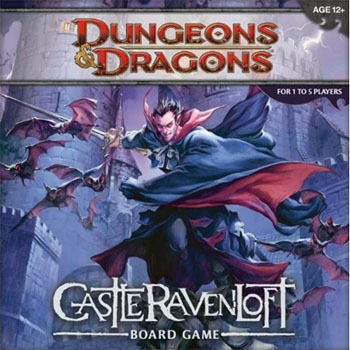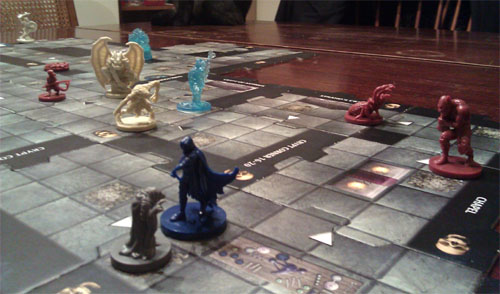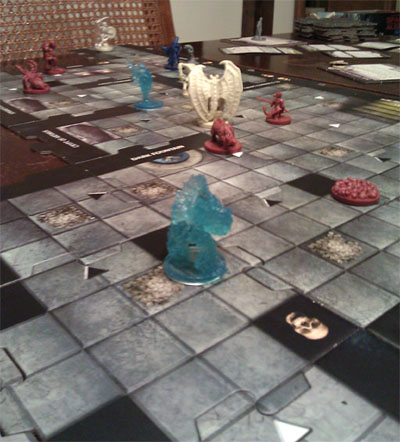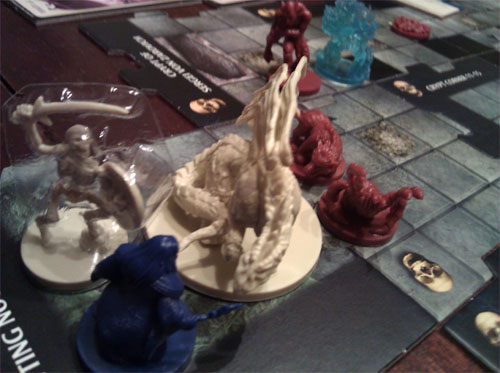 I wasn’t planning on doing this, but almost immediately after writing about my first set of rulebook woes with Castle Ravenloft I ended up playing the solo scenario “Adventure: Impossible” and running headlong into two particularly egregious problems.
I wasn’t planning on doing this, but almost immediately after writing about my first set of rulebook woes with Castle Ravenloft I ended up playing the solo scenario “Adventure: Impossible” and running headlong into two particularly egregious problems.
First, a quick description of the “Adventure: Impossible” scenario: In the scenario you play each of the five Heroes in the game sequentially as they enter Castle Ravenloft’s dungeons in order to defeat 3 of Strahd’s powerful lieutenants. (Which three is randomly determined before the game begins and revealed as you play.) When one hero dies, the next hero arrives.
(Minor problem: The scenario doesn’t specify what happens to the dead Hero’s treasure. It also doesn’t specify what happens to the monsters which were controlled by the dead Hero. I arbitrarily ruled that the dead Hero’s treasure disappeared, but that their monster control cards and traps transferred to the new character.)
The scenario wasn’t going too badly for me until I got an Alarm trap. These traps generate a new monster every single turn until they’re disabled… and I could never get the damn thing disabled. My fighter failed to disable it twice and was then killed. He was replaced by the rogue, who has a +5 bonus to disabling traps (and thus has an 80% chance of success). The rogue failed three times, but was then fortunate enough to get teleported to the far side of the dungeon by an Encounter card. A few turns later, this was my predicament:

The Alarm trap was still spitting out monsters, all of which were pouring across the dungeon towards me. At this point I had killed one of Strahd’s lieutenants and was now engaging Klak. Klak’s appearance was actually quite lucky in some respects because he would cause unexplored tiles to flip over, which gave me room to continue moving away from the monsters pursuing me and, thus, enough time to kill Klak before they reached me.
PLACING MONSTERS
Here, however, we run into our first rulebook woe. The rule for placing Monsters reads:
When you have to “place a Monster” this is shorthand for draw a Monster Card and place the corresponding Monster figure on the bone pile that’s on the Dungeon Tile you just placed. If you already have the same Monster Card in play in front of you, discard that Monster Card and draw again. Note, however, that it’s okay to draw a Monster Card if another player has the same Monster in play.
(Minor problem: You will often be told to “place a Monster” in situations where you haven’t just placed a Dungeon Tile, so the first sentence is actually misleading in addition to being ungrammatical. But that’s just a quibble, really.)
The question becomes: What happens when you already have one copy of every single Monster Card in the game? Should multiple Monsters now be allowed? Or is it now impossible for new Monsters to appear? And if it’s impossible for new Monsters to appear, should I cycle through the entire deck?
I ask that last question, because the game is also unclear on what you should do when you get to the bottom of a deck of cards. Should you reshuffle the discards? Or have you simply depleted the dungeon of Monsters? (I think the answer here is pretty obviously “reshuffle”, but once again we’re seeing the sloppiness of the rulebook.)
In terms of whether or not Monsters should be drawn when you already have one copy of each Monster Control card, I see three possibillities:
(1) You don’t draw any additional monsters. (This is the most literal interpretation of the rules; it is also the most favorable to the players.)
(2) Draw an additional control card to determine what type of monster to place, place it, but then place the extra control card under the existing control card. The new monster will still be activated by the control card already in your hand. If one of these monsters is killed, remove one control card to your XP pile normally while leaving the other in play. (This allows new monsters to continue entering play, but doesn’t result in a single player activating the same monster multiple times on their turn.)
(3) Draw an additional control card, place the monster, and resolve the additional control card normally. (This is the most punitive possibility, since it means that the active player will be activating those monsters twice.)
I decided to go with the first possibility in thie scenario, largely because the alternative was pretty much certain death. In the future, however, I might actually use a house rule in which scenario #2 is always used when a duplicate control card is drawn. It might make the game slightly more difficult, but in a way that I feel would be more enjoyable and universally consistent.
TACTICAL FAIL
In any case, I’d managed to kill Klak, but the monsters were still coming.

oh shit…
I had them strung out pretty well so that I could take them one at a time, but the problem was that as soon as I killed one of them the Alarm trap would immediately respawn them. And I couldn’t keep that up indefinitely because the encounters would slowly whittle me away.
But then I got lucky and pulled a treasure that would let me teleport all the way back to the other side of the board where I could deactivate the Alarm trap.
… instead I missed the die roll three more times.
(If you’re keeping track at home, I have now missed the die roll seven times. One of these had a 55% chance of success and the others all had an 80% chance of success, meaning that there’s only a 0.002% chance that something like this could happen.)
I’m now down to 1 hp and the monsters are closing in, but I have a clever scheme which will allow me to circle around a corridor loop in the randomly generated dungeon, pull the monsters away from the Alarm trap, and give me one more shot at disabling the thing.
… except for the encounter card which teleported a spider right next to me for a guaranteed kill.
At this point, the cleric — my last Hero in the scenario — teleports in and makes a beeline for the Alarm trap. Once there, he proceeds to blow his disarm roll three more times. (I am officially done calculating the probability on this one.)
With more monsters closing in, the cleric fled down the hall, where he promptly discovered the Zombie Dragon (Strahd’s third lieutenant) lurking in a the Rotting Nook:

This does not look good.
And here, as the Zombie Dragon pins me in the corner, we reach our second rulebook woe. When a monster activates, you are supposed to check the Monster Tactics listed on their control card. The rules for this are:
- The Monster’s tactics are presented as a list. Each possible maneuver for the Monster starts with a statement. If that statement is true, the Monster follows the resulting tactics.
- If the statement is not true, go on to the next statement. If that statement is true, the Monster follows the resulting tactics.
- Once a Monster has selected and followed one set of tactics, the Monster’s turn ends. Do not continue to check its remaining tactics that turn.
What these rules fail to address is a situation in which a tactics statement is true, but the resulting tactics cannot be executed. For example, in the picture above my cleric is boxed into the corner by a skeleton and the Zombie Dragon. As a result, there are no adjacent spaces open next to the cleric. You can see just beyond the Zombie Dragon that there is a wolf and a spider waiting to pounce me. The wolf’s tactics read:
- If the Wolf is adjacent to a Hero, it attacks that Hero with a bite.
- If the Wolf is within 2 tiles of a Hero, it moves adjacent to the closest Hero and attacks that Hero with a pounce.
- Otherwise, the Wolf moves 2 tiles toward the closest Hero.
The first line doesn’t apply since the Wolf isn’t adjacent. The second line does apply (the Wolf is within 2 tiles of the cleric), but it can’t move adjacent. Does that mean it doesn’t attack at all? And, if so, should I instead execute the third line of the Wolf’s tactics? What if this wasn’t a solo scenario and the closest Hero was boxed in but there was another Hero within range who wasn’t? Should the Wolf attack the available target or freeze-up on the unavailable target?
Then consider that the spider’s tactics unambiguously trigger a web attack. (“If the Spider is within 1 tile of a Hero, it attacks the closest Hero with an acidic web.”) But the spider’s web attack is a +11 attack with the effect, “1 [damage] and Slowed. Place the Spider adjacent to the Hero.” Should the spider deal damage and then not move? Or is the entire effect canceled since part of it can’t apply?
What would probably be useful is a general rule for handling occupied spaces. Maybe something like, “If a Monster must move to or appear in a particular space and all possible spaces are occupied, the monster instead moves to an adjacent space.” This doesn’t necessarily clear up the question of whether or not the Wolf would be allowed to attack even though they didn’t get adjacent to their target, but it would help.
It would also clear up another issue with the “place a Monster” rules: What happens if the bone pile is already occupied by another monster? (Since many monsters won’t move when they appear and several encounters spawn multiple monsters, this situation actually crops up quite frequently.) We’ve been playing with the “place them in an adjacent space” rule since it obviously makes the most sense.













ARCHIVED HALOSCAN COMMENTS
Echo 1 Items
Leland Tankersley
The programmer in me sees a fourth, degenerate possibility:
(4) You follow the RAW, drawing and discarding every Monster Card until the deck is exhausted. Then, you reshuffle and continue drawing and discarding every Monster Card until the deck is exhausted … lather, rinse, and repeat until you get bored, then put the game away.
FWIW, in the case where a monster tactic can’t be executed, I think I’d say “execute the next applicable tactic, unless none apply or none can be executed, in which case do nothing.” I wouldn’t allow the Wolf to attack; in your situation it would sit there growling and waiting its turn at the lunch buffet. There might be a way to exploit this behavior in multiplayer, but honestly if you can figure a way to turn it to your advantage I think that’s a good thing.
Monday, January 17, 2011, 8:34:41 PM
My favorite tactical Ravenloft moment was while playing the Elf Wizard, a character that is not meant to explore anything. I revealed a tile with a Ghoul, was paralyzed, and then hit with a spear trap. Then I raised an angry fist to the sky and yelled, “GYGAX MADE ELVES IMMUNE FFFUUUU!!”
LOL
I found this game, as well as its counterparts ashardalon and drizzt , suffer greatly from interpretation ambiguity and vaguely structured sentences / rules. The designers REALLY should have sought the help of someone in linguistics. I noted in playing that almost every issue I had with rule interpretation (which happened most turns) could have been resolved by a little more text, or at least a little more deliberate/technical text. Anyway I’d like to as a question. Are villian actions to be interpreted the same as monster actions? Does a villian like klak perform the first possible attack like most monsters or all possible attacks. Additionally with the gargoyle and blazing skeleton how do we interpret the multi target attack. It reads “he attacks each hero with a blazing fireball”. So one fireball with one role that will hit or miss based on AC, or one attack of a fireball with separate rolls per hero?